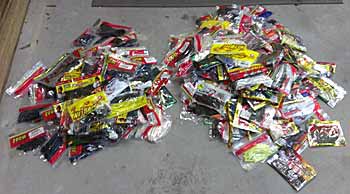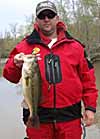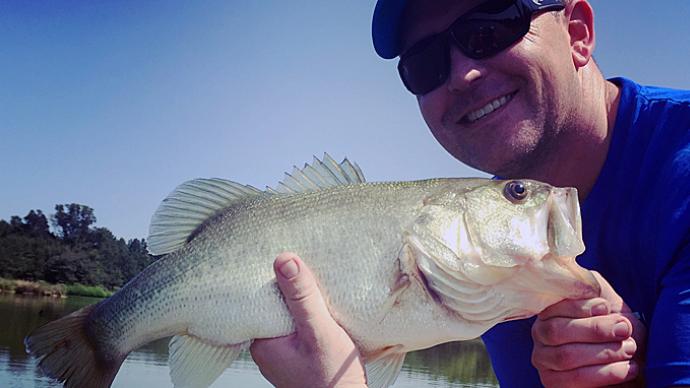
How many of us have been through this? You have some downtime in the winter to re-organize your tackle, and you begin to see a pattern with your soft plastic lures. The number of bags in the pile you use is often smaller than the number of packs of lures you own. Why is this? If you’re like me, then the reason is simple. I like spending money on fishing, and when I get excited about a new lure or one that I’ve just been introduced to, especially a soft plastic, I go a little crazy with my spending. Unfortunately, this causes me to have an overabundance of lures in colors that I generally wouldn’t use. This doesn’t happen overnight, mind you. Usually, after several years of anglers experimenting with what kind of plastic baits and in what colors they most often use, they will be stuck in this situation.
What’s the solution to this problem? Don’t you get excited about using and buying plastics? That wouldn’t work. Spending money on our favorite hobby is a big part of what excites us all about fishing. We love our toys. Continue to buy everything on a whim and grow your pile of unused bags of plastics? That’s just throwing money away if you never use those lures. In the rest of the article, I will discuss a set of options that I believe will cut down on the number of lures you’ll own that will never see the water and save you a little dough.
First of all, I’d like to discuss the color selection. I mentioned that one of my problems in the past was getting excited and buying up every pretty color that plastic was offered. Over the last five or six years, I’ve been reading articles by the pros and other experts, watching videos, and recording information from my fishing experiences. This has led me to narrow my color selection to three basic colors. Fishing in south Louisiana, I’ve determined three colors that work for me. You may choose three colors different than mine that will work better for your area of the country. Our water tends to be dirtier than most of the country, so you may lean toward more natural colors if your water is cleaner and clearer. I choose which of the three colors to tie on based on the water conditions I’m faced with for the day.
Clear to Lightly Stained water - Green Pumpkin
Lightly Stained to Stained water - Junebug
Stained to Muddy water - Black/Blue or some other variation of Black
The only exception I make is when throwing a soft plastic jerkbait of some type. Then I’d also substitute White or your preferred Shad/Shiner color to that list.
I’m certainly not saying that other colors aren’t good. If you come across a “magic” color on a particular body of water, then by all means, you need to add that to your repertoire when fishing there. We’ve all been clued into a good color by a friend or competitor. In general, though, these three colors are a great starting point and will help minimize the frustration associated with the realization that you purchased something that you won’t use.
The other half of this equation is narrowing your lure models for each type of soft plastic bait you’d fish. We all know that hundreds and possibly thousands of soft plastic manufacturers are out there. Many make great lures, so I’m not knocking anyone out there producing these baits. With that said, you don’t need to buy a craw from every brand on the market. Sure, some testing is required to determine your preferred use. However, just as you will limit yourself to just a few colors, you should limit yourself to just a few brands or models of each lure type.
I suggest that you make a list of the techniques or categories that require a soft plastic lure. Jerkbait/minnow, craws, lizards, creatures, stick baits, toads, grubs, swimbaits, tubes, trailers, etc. Also, consider the techniques that work well in your area and prioritize the order you’ll restock. For instance, I never throw a grub in south Louisiana so I wouldn't purchase any grubs in the spirit of this exercise. Again, that’s not to say that a grub wouldn’t work. I don’t use them for several reasons. Primarily because in any instance I could think of using one, there’s another lure that I have as much or more confidence in using. Once you have your list of the types of lures you plan on using throughout the year, you’ll need to select a model or two (or even three if you already know of specific applications to use all of them) of each category to stock in your tackle box.
Let’s use craws, for example, since there seems to be an endless supply of manufacturers and models on the market today. I’ve tried many brands of soft plastics over the years, and the one I buy most often is Zoom. The main reason is that they make a bait in all these categories, have a great color selection, and are easy to find in my area. They are not the only brand I buy, but they are an excellent fit for this example. Zoom makes five different varieties of plastic craw, and I’m sure there’s an application for every one of them. You could make a case that as an excited angler who needs some craws and sees these products for the first time, you’d want to buy all five models in the three colors we mentioned earlier. However, this would be counterproductive and could leave you with more unused lures than before.
A better thing to do would be to examine what each of the craws does. The Magnum Ultra Vibe Speedcraw, the Critter Craw, and the Z Craw generally have straight appendages. They are well suited for easily moving through grass or thick cover. So, I’d likely use these in some sort of heavy flipping application or possibly even pitching around the grass. Of course, you may use it for other things, but those techniques jump out to me at first glance. On the other hand, the UV Speed Craw and Super Speed Craw have bigger claw appendages that will move more water and grab at more cover than the three previously mentioned models. You might want to use these craws for pitching in sparser grass, around wood, or even as jig or bladed jig trailers. This is something you’ll get to experiment with once you’ve made your decision on which models to buy. You may find that in the end, you use the UV Speed Craw for all applications because it’s compact enough to punch in heavy cover and offers enough movement for normal flipping and pitching applications.
It sounds as if I’m telling you to buy all five craws offered, but I’m not. What I would suggest is purchasing one from each area. Perhaps the UV Speed Craw and the Critter Craw to start in the case of the two categories I’ve developed above. You may not live in an area that offers thick cover, such as matted grass. For someone in that situation, you might want to buy the craws that move more water and stay away from the streamlined versions. Whatever you decide is fine. It’s a starting place where you’ll get some new lures to try without breaking the bank. If you decide you don’t like what you’ve chosen, then since you only purchased three colors and not all thirty-three colors (as offered with the UV Speed Craw), you won’t have nearly the amount of packs of lures in the ole unused and unwanted pile of soft plastic baits.
Continue doing this for the other categories/techniques you want to fish or learn. In the end, you’ll be left with a streamlined system of soft plastic baits that will get you through any fishing condition that Mother Nature can throw your way.
What to do with the extra baits that you may have already accumulated? I hold onto mine. I’ve already spent the money, so no point in just tossing them out. They can still be useful. One of my favorite things to do with them is to use them when bank fishing. Many ponds aren’t pressured very much, so the fish in them will eat just about anything you show them. The other thing I do with those extra baits is to use them for fun fishing days. I fish in some tournaments, so I’ve got competition days, practice days, and just normal days when I’m out fishing that has no bearing on a competitive event. Those are the days that I try to use some of the colors I wouldn’t generally use. It helps to get rid of them, and you never know when you’ll discover one of those “magic” colors I mentioned at the beginning of the article. If all else fails in this area, they make an excellent gift to someone who’s just starting out in bass fishing and could use some tackle to get started.

Gary Mumphrey grew up in south Louisiana and resides in Baton Rouge, Louisiana. Gary grew up fishing and hunting with his father, where he learned to enjoy and appreciate the outdoors. Since graduating from Louisiana State University in 2006, he has been a member of B.A.S.S. and fishes BASS Federation Nation, FLW’s BFL circuit, Media Bass Team events, and local club level and charity tournaments. Gary is sponsored by Sure Strike Lures in Gonzales, Louisiana.
BassResource may receive a portion of revenues if you make a purchase using a link above.




